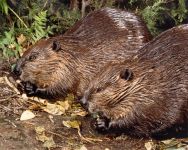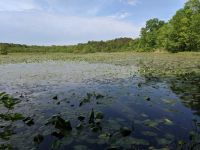


|

|
|
 
|

|
Beaver Tales from Unexpected Wildlife Refuge, December 2019 |
|---|

Thank you to everyone who has supported Unexpected Wildlife Refuge during 2019. In a year when we became increasingly aware of the devastating impact human beings are having on the environment – threatening animal and plant species with extinction – protecting natural habitats and education on the issues has become ever more critical. As part of the globally unique ecosystem that is the Pine Barrens, our Refuge plays an important role in protecting pristine forest, fields, bogs and waterways from human encroachment, thereby providing a safe home to many species, including some officially listed as endangered or threatened in New Jersey. Public education about the importance of wildlife and habitat protection and working with individuals and communities to peacefully resolve conflicts with wildlife are also important areas of our work, this year and always.
As part of our efforts to secure the long term future of the Refuge, we embarked this year upon one of our most ambitious and challenging projects to date, to construct a building that will provide a new administrative base for the Refuge and accommodation for our onsite manager. An update on our progress is included in this newsletter. We are extremely grateful for all the generous donations we have so far received towards this project, enabling and encouraging us to begin construction. Your additional and continued support, however, is still urgently needed, so if you have not already made a donation, please consider doing so now.
There are also many other ways in which you can support the Refuge – and further information can be found near the end of this newsletter – whether by volunteering at the Refuge, holding an event to raise funds or by sponsoring a Refuge habitat or supporting one of the species of animals who are able to live freely here without human persecution or interference. We hope that we can rely on your continued support now and during 2020.
Our snapshots of life at the Refuge provide a fascinating insight, but nothing compares to being here. We hope that, during 2020, you will find time to visit and enjoy the Refuge in person!
We wish you and yours a peaceful New Year.
Here are a few of Maureen Koplow's vegan recipes she provided for other Refuge volunteers.